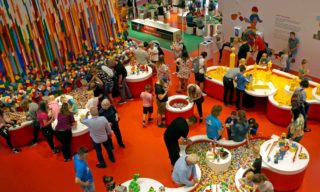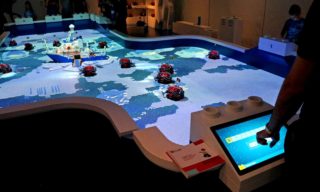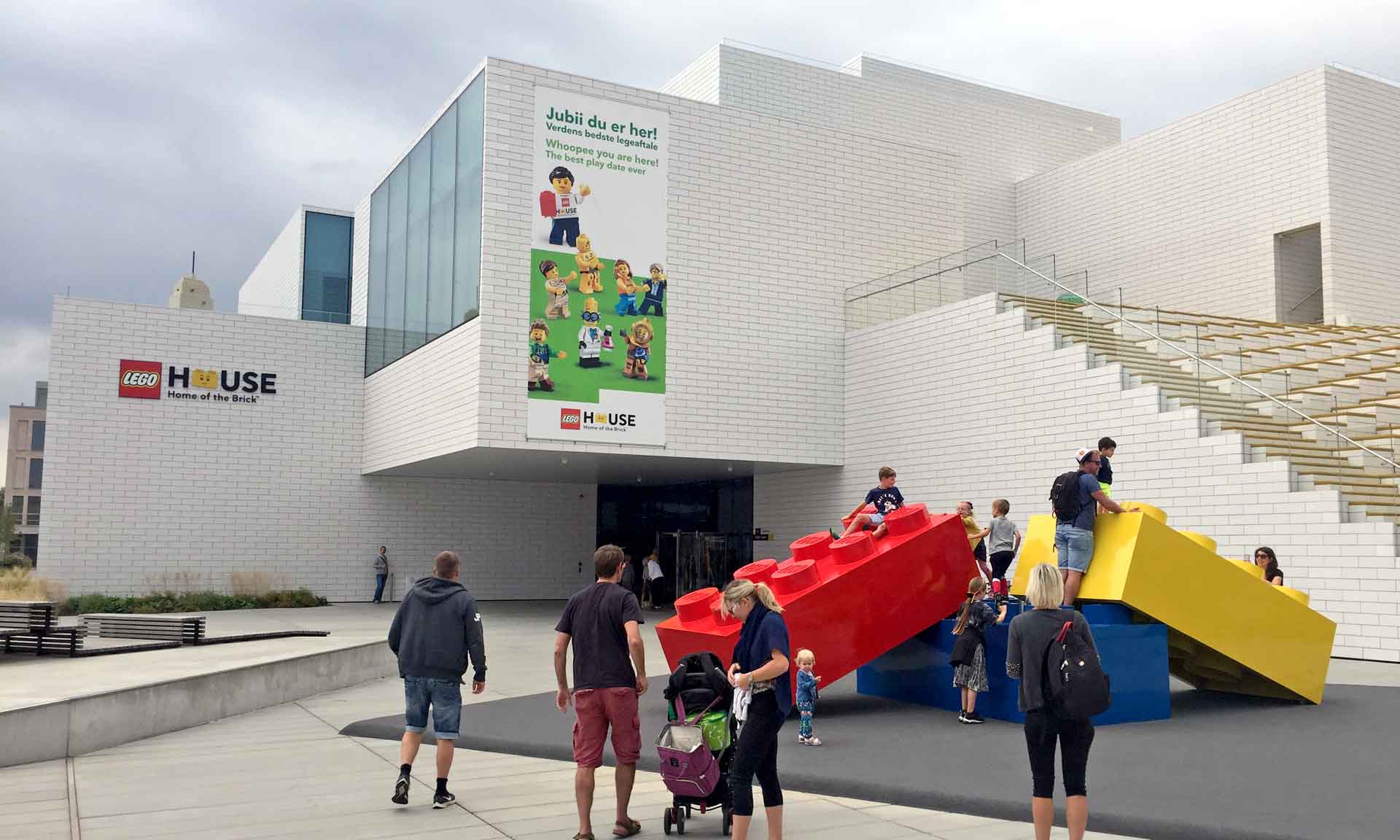The “Home of the Brick” augments visitor creativity and play with just a touch of technology.
I was fortunate enough to have the opportunity to visit Billund, Denmark, home of the LEGO company, the original LEGOLAND, and most recently, LEGO House. A brand museum combined with an experience center, LEGO House aims to inspire learning through play, using the company’s own building blocks as the basis for a series of experiences. Here’s what I encountered inside its brick walls.
LEGO House was designed by Danish starchitect Bjarke Ingels as a cluster of 21 giant blocks. Each is wrapped with white brick tiles from the outside, and has a colorful roof terrace, accessible to visitors; from ground level it looks a bit stark, except for two cascades of blue and yellow bricks that slope down to the street level, providing free public space and Instagram opportunities.
Once inside, the lobby is surprisingly open; the rooms are, in fact, cantilevered to leave a large void at ground level, where visitors can find the shop, cafe, and entry areas. In the center, a staircase winds around a giant tree, more than fifty feet in height, and constructed from more than 6 million LEGO bricks. After scanning my ticket and grabbing my RFID wristband, I was on my way.
Heading upstairs to the top floor, I encountered the first of six color-coded activity zones: the white-hued Masterpiece Gallery. Here, three enormous dinosaurs, each built with a different LEGO brick system, greeted visitors. The perimeter of the room featured fantastic creations from Master LEGO builders around the world, presented as artworks in glass display cases.
 Heading down to the Red Zone, devoted to creative competence, I entered the LEGO Brick Builder room. This gallery’s centerpiece was a giant multicolored LEGO waterfall, surrounded by large, open vats of loose LEGO bricks, and a good crowd of visitors trying their hand. Reticent at first, I was drawn to a monochromatic bin of yellow bricks and began creating a stairway to nowhere. Kiosks here invited visitors to scan their wristband and take a photo of themselves with their creation. The process was simple and effortless, with virtually no language presented on-screen except for the visitor’s name.
Heading down to the Red Zone, devoted to creative competence, I entered the LEGO Brick Builder room. This gallery’s centerpiece was a giant multicolored LEGO waterfall, surrounded by large, open vats of loose LEGO bricks, and a good crowd of visitors trying their hand. Reticent at first, I was drawn to a monochromatic bin of yellow bricks and began creating a stairway to nowhere. Kiosks here invited visitors to scan their wristband and take a photo of themselves with their creation. The process was simple and effortless, with virtually no language presented on-screen except for the visitor’s name.
The Red Zone also included two other areas that I didn’t explore in-depth: a library of LEGO-related publications, and the Creative Lab, which offered mediated build sessions with expert staff advisors to help visitors realize their ideas. I was a little underwhelmed with this zone, which seemed a bit generic – I’d already seen open bins of bricks in the lobby – so I was eager to see what was next.
I entered the Blue Zone, focused on building cognitive competence. The first gallery, Test Driver, provided more bins of bricks, but this time with a variety of wheel assemblies. The challenge here was to build a vehicle and try it out on two test tracks, one a synchronized car race, the other a death-defying leap through a hoop. There was little to no text interpretation here, and only a few facilitators to be found, but it was fascinating how visitors intuitively knew what to do.
 Next was my favorite space in LEGO House, City Architect. Here, large tabletops hosted a grid of projected streets, with animated minifigs traversing the city. Visitors were invited to build their own city blocks in color-coded categories representing residential, commercial, industrial, and parkland use. As each creation was placed in the street grid, the virtual inhabitants reacted to the new configuration, much like Sim-City citizens. It wasn’t as complex as that game, of course, and there are no dashboards of city statistics, but there was still something immediately engaging about redesigning the city and seeing it spring to life.
Next was my favorite space in LEGO House, City Architect. Here, large tabletops hosted a grid of projected streets, with animated minifigs traversing the city. Visitors were invited to build their own city blocks in color-coded categories representing residential, commercial, industrial, and parkland use. As each creation was placed in the street grid, the virtual inhabitants reacted to the new configuration, much like Sim-City citizens. It wasn’t as complex as that game, of course, and there are no dashboards of city statistics, but there was still something immediately engaging about redesigning the city and seeing it spring to life.
 Robo Lab was perhaps the most complex experience of all. In this timed challenge, 15 visitors stood around a giant projected map of an Arctic landscape, populated by real-life LEGO robots. Players used touchscreen stations to program the robots, dragging-and-dropping simple command sequences to guide them across the gameboard and defrost trapped minifigs and Woolly Mammoths (!) frozen in the ice. This was a nice blend of digital and physical interaction – a little confusing at times, but impeccably designed, as with most everything I encountered.
Robo Lab was perhaps the most complex experience of all. In this timed challenge, 15 visitors stood around a giant projected map of an Arctic landscape, populated by real-life LEGO robots. Players used touchscreen stations to program the robots, dragging-and-dropping simple command sequences to guide them across the gameboard and defrost trapped minifigs and Woolly Mammoths (!) frozen in the ice. This was a nice blend of digital and physical interaction – a little confusing at times, but impeccably designed, as with most everything I encountered.
The Green Zone is about social competence; a Character Creator room presents thousands of pieces and invited visitors to build their own minifigures. World Explorer didn’t provide much interaction, but featured enormous models of a mountain village, a city, and a tropical island, filled with narrative details.
 More ambitiously, Story Lab prompted visitors to create stop-motion animations; using a LEGO landscape of city, farm, and river, plus minifigs and a few key props, visitors could invent a story and record it frame-by-frame. The on-screen instructions were intuitive and made it fairly easy to build the animation. The station timed out before my masterpiece was complete – I spent too much time ‘casting’ the minifigs – but made up for it by adding credits, music, and charming special effects to the final video.
More ambitiously, Story Lab prompted visitors to create stop-motion animations; using a LEGO landscape of city, farm, and river, plus minifigs and a few key props, visitors could invent a story and record it frame-by-frame. The on-screen instructions were intuitive and made it fairly easy to build the animation. The station timed out before my masterpiece was complete – I spent too much time ‘casting’ the minifigs – but made up for it by adding credits, music, and charming special effects to the final video.
 The Yellow Zone focused on emotional competence by giving visitors the express themselves via the natural world. One room focused on creature creation, with a variety of kinetic tabletops to help bring the bricks to life; another presented a brick garden and invited visitors to create their own flowers. The highlight of this zone was Fish Designer, where I built a fish silhouette out of bricks, scanned it at an interactive station, and watched it swim away into a virtual aquarium. It’s been done before, certainly… but once again, this was a beautifully realized experience, and there were some nice touches in the animation, as the fish expressed a range of emotions depending on what it encountered.
The Yellow Zone focused on emotional competence by giving visitors the express themselves via the natural world. One room focused on creature creation, with a variety of kinetic tabletops to help bring the bricks to life; another presented a brick garden and invited visitors to create their own flowers. The highlight of this zone was Fish Designer, where I built a fish silhouette out of bricks, scanned it at an interactive station, and watched it swim away into a virtual aquarium. It’s been done before, certainly… but once again, this was a beautifully realized experience, and there were some nice touches in the animation, as the fish expressed a range of emotions depending on what it encountered.
Lastly, I headed down to the basement for the History Collection. Here, a relatively traditional exhibition traced LEGO’s history, from its origins in wooden toys, to the design of the brick, to today’s global empire. A series of interactive stations here invited visitors to browse historic LEGO sets and build a personal digital collection, cementing their relationship with the brand.
With a 90-minute wait time, I didn’t manage to eat at the MINI CHEF restaurant, where visitors ‘design’ their meal by assembling LEGO bricks. Instead, I explored the exterior terraces, which presented a variety of playground activities and photo ops devoted to physical competence; while colorful and fun, these didn’t seem to have much to do with LEGO toys.
 Back beneath the tree, a final stop on the journey gave each visitor six red bricks, freshly molded and packaged from a manufacturing machine in the lobby. Each visitor was assigned a unique assembly configuration of the six bricks (out of the more than 900 million possibilities). This is a fantastic parting gesture, connecting the massive possibilities of the brick system with the notion of personal customization that makes LEGOs so powerful.
Back beneath the tree, a final stop on the journey gave each visitor six red bricks, freshly molded and packaged from a manufacturing machine in the lobby. Each visitor was assigned a unique assembly configuration of the six bricks (out of the more than 900 million possibilities). This is a fantastic parting gesture, connecting the massive possibilities of the brick system with the notion of personal customization that makes LEGOs so powerful.

Using the LEGO House mobile app, I was able to collect and download all the images and videos I created on-site. It was a great souvenir of my visit, and reminded me of how my initial reticence to play with bricks at LEGO House quickly disappeared.
In both the technology-driven and analog spaces, LEGO House succeeds in getting visitors to join in – not that this is a problem, with the world’s most popular building set. But most impressively, the simplest of prompts and directives are all it needs to nudge visitors to explore story, nature, science, and play.



